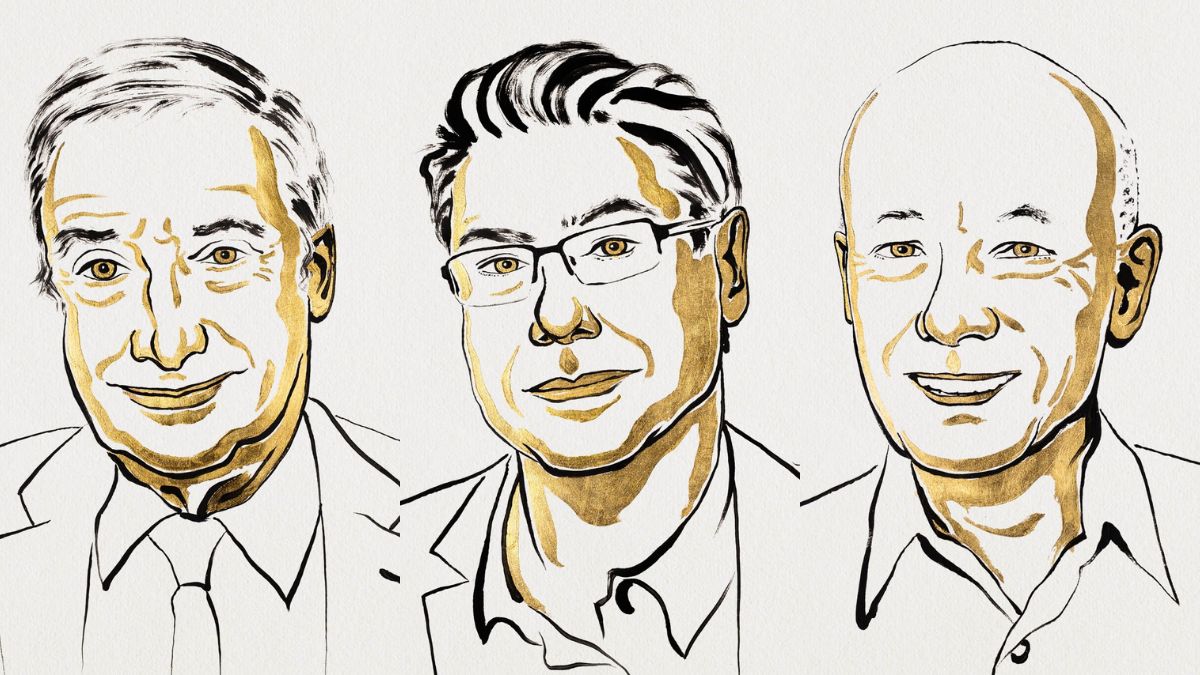The minds that move economies
 Illustrations by Niklas Elmehed of the winners of Sveriges Riksbank Prize in Economic Sciences in Memory of Alfred Nobel 2025; From left: Joel Mokyr, Philippe Aghion, Peter Howitt | Niklas Elmehed / Nobel Prize Outreach
Illustrations by Niklas Elmehed of the winners of Sveriges Riksbank Prize in Economic Sciences in Memory of Alfred Nobel 2025; From left: Joel Mokyr, Philippe Aghion, Peter Howitt | Niklas Elmehed / Nobel Prize Outreach
Economic headlines in 2025 read like a weather report: sudden storms, unpredictable currents and flashes of breakthrough amid uncertainty. Against this backdrop, the Royal Swedish Academy of Sciences has awarded the Sveriges Riksbank Prize in Economic Sciences in Memory of Alfred Nobel 2025 to Joel Mokyr, Philippe Aghion and Peter Howitt for having explained innovation-driven economic growth.
One half of the prize went to Joel Mokyr of Northwestern University and Tel Aviv University for having identified the prerequisites for sustained growth through technological progress. The other half was shared between Philippe Aghion (Collège de France, INSEAD and LSE) and Peter Howitt (Brown University) for the theory of sustained growth through creative destruction. Their collective work explains why technological change, institutional openness and competition have transformed economies from stagnation to self-reinforcing progress.
Joel Mokyr: The architect of useful knowledge
Joel Mokyr, born in Leiden in 1946, is the Robert H. Strotz Professor of Arts and Sciences at Northwestern University and Professor of Economics and History. Drawing on Europe's economic history (1750–1914), he uncovered how "useful knowledge"—practical, testable know-how built on scientific understanding—became the true engine of sustained growth.
In The Lever of Riches and A Culture of Growth, Mokyr shows that progress endures only when societies institutionalise curiosity and experimentation. His framework rests on three mutually reinforcing pillars:
Useful knowledge: the accumulation of scientifically grounded, practical information.
Mechanical competence: society's ability to convert ideas into working technologies.
Supportive institutions: laws, governance and cultural norms that reward innovation.
By linking the Enlightenment's scientific mindset to the Industrial Revolution, Mokyr explained why Europe broke the pattern of historical stagnation. His analysis, grounded in archival and quantitative research, informs modern policy thinking on skills, education and innovation systems.
Mokyr has received honours from the American Economic Association, the International Balzan Prize Foundation and is a Clarivate Citation Laureate—recognition of a lifetime spent proving that prosperity is built on ideas societies choose to value.
Philippe Aghion and Peter Howitt: The mathematics of creative destruction
Philippe Aghion, born in Paris in 1956, is a Professor at the Collège de France, the Kurt Björklund Chaired Professor of Innovation and Growth at INSEAD, and a Visiting Centennial Professor of Economics at the London School of Economics. Peter Howitt, born in Canada in 1946, is Professor Emeritus of Economics at Brown University.
Their landmark 1992 Econometrica paper, A Model of Growth Through Creative Destruction, provided the first formal mathematical model of Schumpeter's intuition that innovation both creates and destroys. Each wave of technological advance displaces obsolete firms and products while opening new opportunities-an endless cycle that powers sustained growth.
The model revealed why innovation also generates conflict: incumbents have incentives to block change. Managing these tensions, through competition policy, research incentives and social protection, became a central challenge for policymakers.
Their ideas now underpin much of today's innovation policy framework. The OECD-World Bank report Innovation and Growth (2009) explicitly identifies the Aghion-Howitt neo-Schumpeterian model as the foundation for policy advice on R&D, education and market competition. Subsequent OECD productivity studies confirm the model's "inverted-U" relationship between competition and innovation (Aghion et al., 2005), used to calibrate guidance for member states on fostering innovation without stifling risk-taking.
Within the Centre for Economic Policy Research (CEPR), where both scholars are long-time fellows, the model remains central to research on growth and inequality. CEPR's VoxEU publications routinely cite Aghion and Howitt (1992) when analysing innovation incentives, and CEPR's 2025 statement following their Nobel Prize reaffirmed the model as the "theory of sustained growth through creative destruction."
Policy influence: From theory to practice
The creative-destruction framework has directly informed debates on how to sustain innovation in advanced economies.
In Finland, the Economic Policy Council's 2018 report on innovation policy explicitly cites Aghion & Howitt (2009) to argue that “innovation-driven productivity is the main driver of economic growth." Analysts have since warned that the "rate of creative destruction"—the renewal of industries through entry and exit—has slowed, prompting Business Finland's 2024 agenda to call for faster renewal dynamics.
In South Korea, policymakers are increasingly referencing Aghion's ideas. Kang Hoon-sik, as a legislator, quoted The Power of Creative Destruction, calling for a society that is "as innovative as the US system and as protective and inclusive as the Danish system."
Lee Yun-soo, professor of economics at Sogang University, has publicly argued that "Korea's industrial policy is strong for creation, but weak for destruction", warning that weak exit dynamics may leave incumbents sheltered and block renewal.
Peter Howitt, after receiving the Nobel, emphasised in comments that "strong antitrust policies" are crucial for continued innovation in South Korea.
When ideas shape economies
The achievements of Mokyr, Aghion and Howitt show that prosperity is not self-sustaining; it depends on societies that preserve the conditions for discovery and renewal.
Mokyr revealed how cultural openness and knowledge exchange made progress cumulative. Aghion and Howitt built the tools to measure and manage that process in real time.
Their Nobel Prize recognises more than academic theory; it honours a blueprint for how economies can keep evolving, balancing innovation with inclusion, and ensuring that progress never becomes complacency.
The opinions expressed in this article are those of the author and do not purport to reflect the opinions or views of THE WEEK.
Business